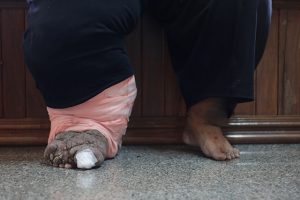
Filariasis – causes, side effects and treatments at NaturalPedia.com
Wednesday, April 04, 2018 by Ralph Flores
http://www.naturalpedia.com/filariasis-causes-side-effects-and-treatments-at-naturalpedia-com.html

The term filariasis is an umbrella term that describes an infection caused by parasitic roundworms of the superfamily Filarioidea. When it is transmitted to a human host, it invades tissues under the skin and the lymphatic system, and it can cause complications which range from acute inflammation to chronic scarring.
There are various conditions that a person can have depending on the filarial parasite causing the infection.
- Onchocerciasis, also called river blindness, is caused by the filarial worm Onchocerca volvulus. The condition can create severe itching and skin conditions. If O. volvulus infects the eye, it can lead to visual impairment or blindness. It usually occurs in tropical areas, particularly in sub-Saharan Africa.
- Lymphatic filariasis is a condition which causes elephantiasis and lymphedema and is a leading cause of disability worldwide. Wuchereria bancrofti causes most infections, but in Asia, the disease is caused by Brugia malayi and Brugia timori worms.
- Loiasis, commonly referred to as African eye worm, is caused by the parasitic worm Loa loa. When a person is infected with the disease, a pruritic rash called a Calabar swelling appears in the body. In Africa, at least 29 million people have loiasis, according to the Centers for Disease Control and Prevention.
- Mansonelliasis is a rare form of filariasis characterized by the onset of fever, vertigo, muscle and joint pain, and a cold sensation in the legs.
- Dirofilariasis is caused by either the Dirofilaria immitis and Dirofilaria (Nochtiella) repens filariae, and it primarily invades the lungs. D. immitis (commonly referred to as heartworm), is known to be fatal to dogs and other mammals.

Known risk factors and symptoms of filariasis
Each specific disease under filariasis has its own unique set of symptoms and complications.
The hallmark symptom of lymphatic filariasis is the swelling of the limbs or genitals, as a result of lymphedema. Other symptoms include the following:
- A fever unrelated to any inflammation in the lymph nodes – called a filarial fever
- Sudden onset of fever and an abnormal swelling in the lymph nodes
- A dry cough that recurs at night
An onchocerciasis infection will result in the following symptoms:
- Dermatitis – This will usually include edema, itching, reddening of the skin, the appearance of scabs, and lichenification (leather-like skin).
- Skin nodules – It normally appears in bony areas of the body depending on where the roundworm infection is located.
- Ocular lesions – Depending on the severity of the infection, this can result in a loss of visual acuity.
Infections due to loiasis will result in a Cabalar swelling – large subcutaneous edema that is the body’s reaction to the parasite. In some cases, this can affect the conjunctiva, which can irritate the eye.
Finally, a mansonelliasis infection is usually asymptomatic. However, when there are symptoms, this will involve a high fever, itching of the skin, the appearance of skin lumps, and sharp abdominal pain.
Body systems affected by filariasis
Complications from filariasis could be anywhere from asymptomatic to chronic, depending on the severity of the condition. In acute cases, this will lead to changes in the skin, lymph nodes, and lymphatic vessels.
However, chronic cases will involve the development of chronic lymphoedema, also known as elephantiasis. Fluids may also accumulate in the limbs and may also affect the genital organs.
Food items or nutrients that may prevent or relieve filariasis
There are some natural ways to manage filariasis. In Ayurvedic medicine, herbs such as Nityananda Rasa is used. Eating 10 cloves of garlic a day is also helpful in relieving the symptoms.
Treatment and management options for filariasis
Healthcare professionals will recommend antibiotics to treat filariasis. However, in cases where elephantiasis has already occurred, surgery may be considered to manage the condition.
Where to learn more
- 10 Deadly organisms that live in your body
- Health.news
- Medicine.news
- NaturalCures.news
- Nutrients.news
Summary
Filariasis is an umbrella term that describes an infection caused by parasitic roundworms of the superfamily Filarioidea. When it is transmitted to a human host, it invades tissues under the skin and the lymphatic system. Complications can range from acute inflammation to chronic scarring. To treat filariasis, healthcare professionals will normally recommend antibiotics or surgery.
Sources include:
Tagged Under: Tags: filariasis





